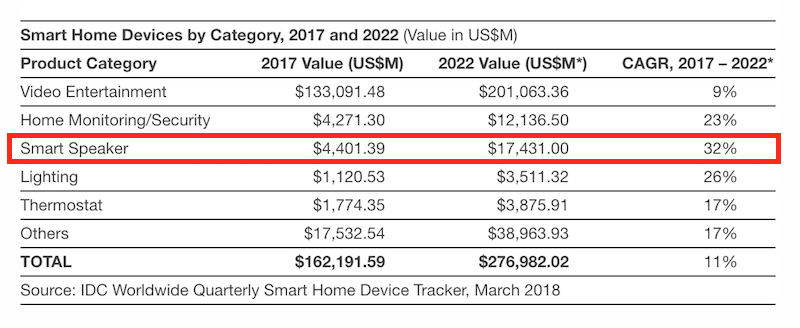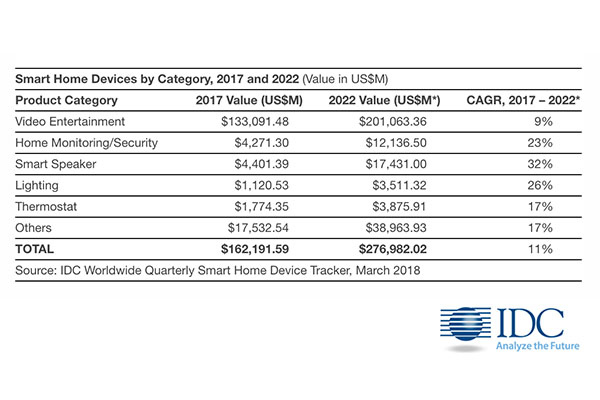IDC Says Smart Speaker Sales to Rise from $4.4 Billion to $17.4 Billion by 2022
IDC has released a new smart home device forecast that estimates 2017 smart speaker sales were $4.4 billion and will grow to $17.4 billion in 2022. That revenue rise reflects a 32% compound annual growth rate (CAGR). The smart speaker growth rate, which includes devices such as Amazon Echo, Google Home and Apple HomePod, is about three times higher than the expected 11% CAGR for the smart home segment overall.

While the report focuses on device sales, it also points out that the bigger revenue opportunity in the smart speaker segment is likely to be in software and services. “Amazon and Google have been quick to respond by offering additional models and price points through their first-party speakers and by partnering with numerous other brands to bring Alexa- or Google Assistant-enabled speakers. What remains to be seen is how long the partners can survive since the sale of hardware stands to be the smallest part of the overall revenue associated with this category.”
Smart Home Device Sales Will Rise to Nearly 1 Billion
The bulk of the analysis centers around other smart home categories such as video entertainment, home security, lighting, and thermostats. Total device shipments in 2017 for the segment were estimated at 433.1 million units worldwide which was up 27.6% from the previous year. That total is expected to grow to 939.7 million units shipped in 2022 representing an 18.5% CAGR in unit volume. Revenue for the segment will rise from $162 billion to $277 billion during the period. Adam Wright, senior research analyst for IDC’s Consumer IoT Program, commented:
While it’s still early days for the smart home market … we expect to see considerable growth over the next few years, especially as consumers become more aware of and increasingly interact with smart assistant platforms like Amazon’s Alexa and Google Assistant.”
Mr. Wright’s colleague, Jitesh Ubrani, is a senior research analyst for IDC Mobile Device Trackers. He had a similar focus on voice assistants as a central force in the smart home market evolution.
“The smart home market is still in its infancy but we’re already seeing some significant changes in consumers’ and vendors’ approach. There’s less of a focus on having a central hub and apps as the center of the interface as hardware makers race to create interoperability with smart assistants like Alexa, Siri, or Google Assistant.
So, devices are important, but the voice assistants represent what is driving both the market and consumer preferences. That is true despite the fact that smart speakers only accounted for 2.7% of total smart home device revenue in 2017 and will still only represent 6.3% in 2022.
One device type in the “other” category was smart sprinklers. Voicebot recently wrote about a company called Rachio that has developed a smart sprinkler system and received investment from the Amazon Alexa fund. However, the note did caution that these product categories tend to have long replacement cycles and that may limit growth prospects in the near term.
Amazon Echo Maintains Large Market Share Lead in U.S. Smart Speaker User Base
A Timeline of Voice Assistant and Smart Speaker Technology From 1961 to Today
Rachio Snags Amazon Alexa Fund Investment for Wireless Sprinkler Automation









